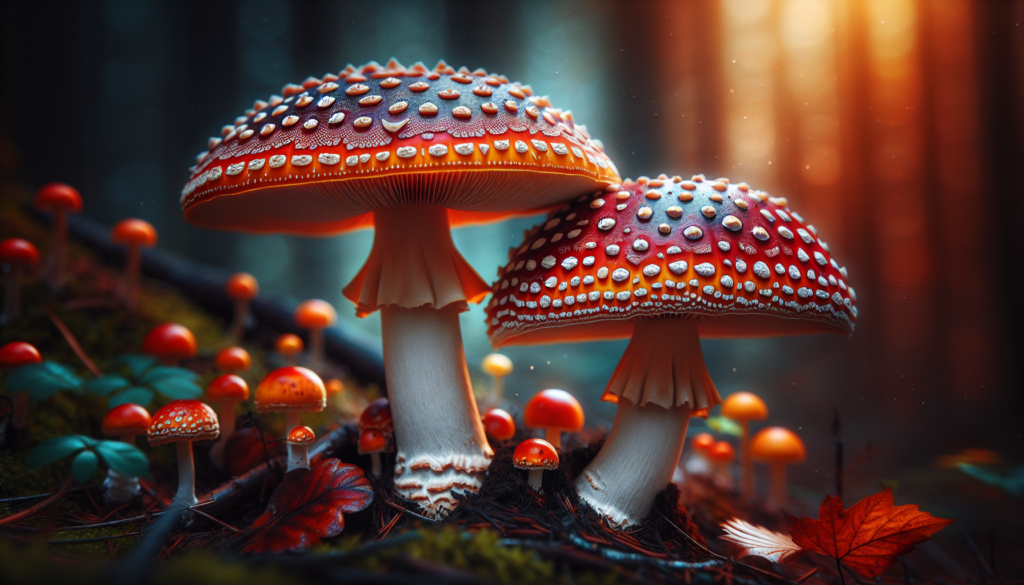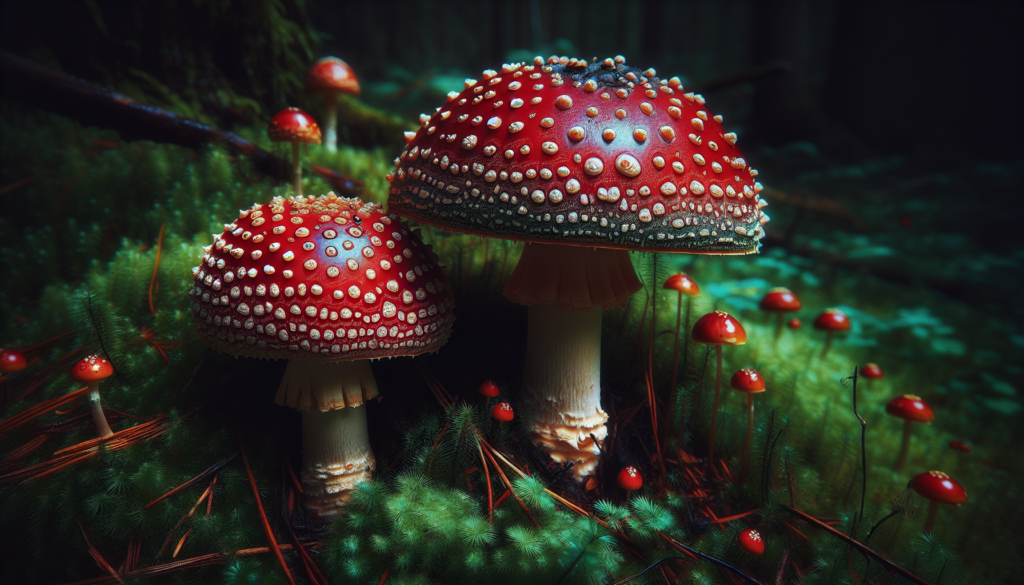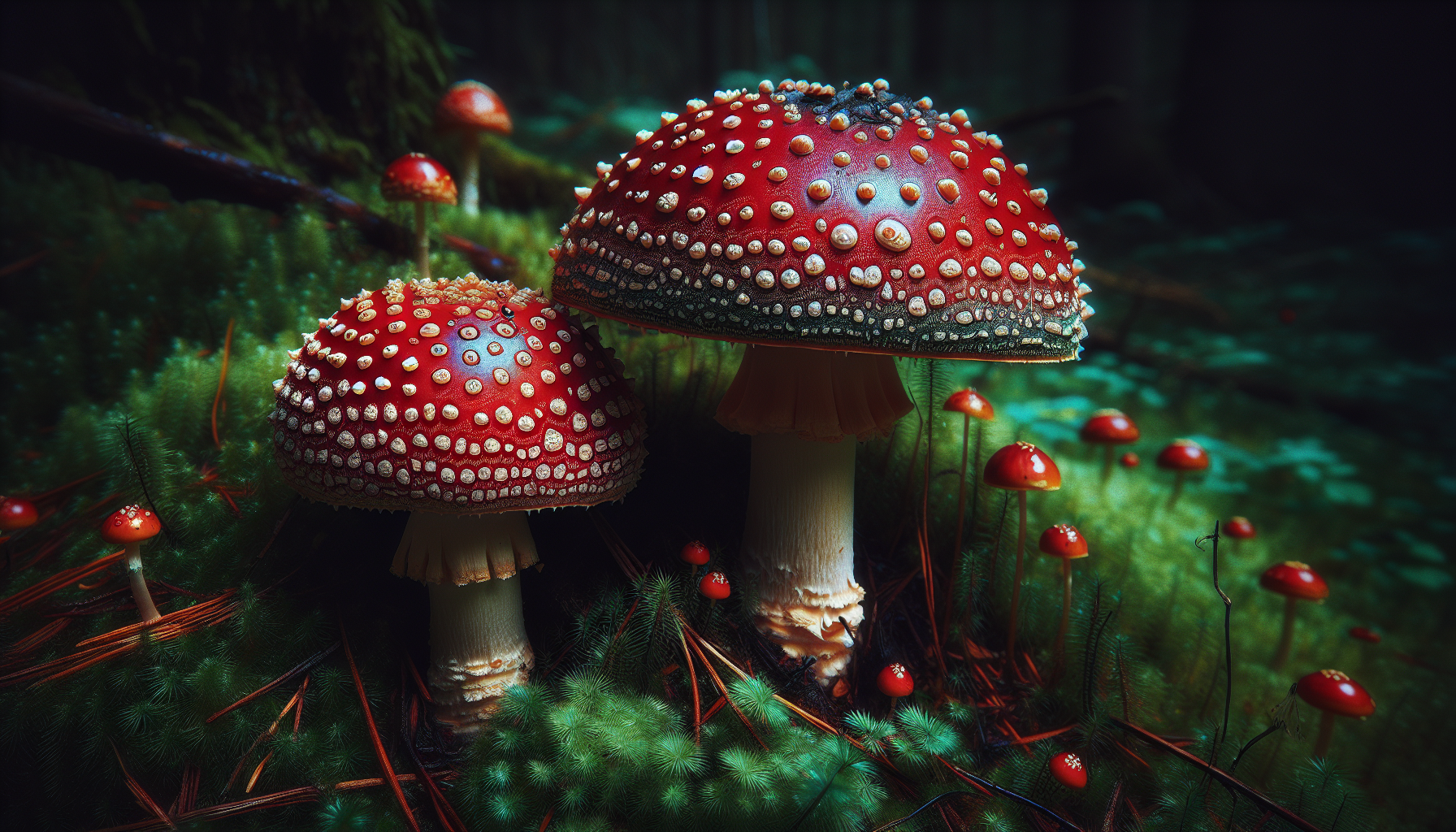In this article, we’ll explore the fascinating differences between two iconic mushrooms: Amanita pantherina and muscaria. These mushrooms, often seen in fairytales and folklore, have distinct characteristics and effects that set them apart. By understanding the unique properties of each, you’ll gain a deeper appreciation for the natural world and the diverse species that inhabit it. So, let’s immerse ourselves in the enchanting world of Amanita pantherina and muscaria mushrooms and discover the remarkable contrasts between them.
Overview
When it comes to the fascinating world of mushrooms, few species captivate the imagination quite like Amanita Pantherina and Amanita Muscaria. These two mushrooms belong to the Amanita genus and are known for their distinctive appearances and intriguing properties. In this article, we will delve into the characteristics, distribution, habitat, toxicity, psychoactive effects, historical and cultural significance, medical applications, legal status, and precautions and safety measures surrounding these remarkable fungi.
Classification
Both Amanita Pantherina and Amanita Muscaria are classified as members of the Amanita genus, which is part of the Amanitaceae family. These mushrooms are part of the Basidiomycota division, known as the club fungi. While they share certain similarities, they have distinct differences that set them apart. Let’s explore their appearances in more detail.
Appearance
Amanita Pantherina
Amanita Pantherina, commonly known as the Panther Cap, is a striking mushroom with a unique appearance. It typically has a large and robust cap, ranging in color from tan to reddish-brown. The cap is covered with white or cream-colored patches, giving it a distinctive speckled pattern. As the mushroom matures, the cap expands and becomes convex. The gills beneath the cap are white and eventually turn pink as the mushroom ages. The stem of Amanita Pantherina is thick, sturdy, and white, often featuring a prominent ring. Overall, its appearance is both elegant and eye-catching.
Amanita Muscaria
In stark contrast to the Panther Cap, Amanita Muscaria, also known as the Fly Agaric, boasts a vibrant and iconic appearance. This mushroom is instantly recognizable with its vivid red cap adorned with distinct white spots. However, it is worth noting that the cap color may vary, with some specimens displaying shades of orange or yellow. As it matures, the cap expands and flattens, sometimes developing cracks or scales. The gills of Amanita Muscaria are white and notched, while the stem is thick, white, and often covered in scales. The striking appearance of the Fly Agaric has captivated the imaginations of artists and storytellers throughout history.

Distribution
Amanita Pantherina
Amanita Pantherina is widely distributed across Europe, Asia, and North America. Within these regions, it can be found in various habitats, including forests, woodlands, and meadows. Its distribution is influenced by factors such as climate, soil conditions, and the presence of symbiotic tree species. The Panther Cap’s ability to adapt to different environments contributes to its widespread prevalence.
Amanita Muscaria
Amanita Muscaria has a broad distribution that spans across temperate and boreal regions of the Northern Hemisphere. It can be found in Europe, Asia, North America, and even parts of South America. This mushroom thrives in a wide range of habitats, including coniferous and deciduous forests, birch groves, and mountainous areas. Its adaptability and symbiotic relationship with certain tree species contribute to its global presence.
Habitat
Amanita Pantherina
Amanita Pantherina primarily favors woodland habitats, often forming mutually beneficial relationships with certain tree species, such as oaks and pines. It thrives in areas with well-drained soil and adequate moisture. This mushroom can be found growing in forests, wood edges, and even urban parks. It is an ectomycorrhizal fungus, forming symbiotic relationships with tree roots, which benefits both the mushroom and the tree.
Amanita Muscaria
Amanita Muscaria is known for its association with certain tree species, including birches, firs, and pines. It forms ectomycorrhizal relationships, enhancing the nutrient absorption of both the mushroom and the trees it associates with. This mushroom is commonly found in damp and cool environments, such as coniferous or mixed forests. It often thrives in areas with acidic soil, where its symbiotic relationships contribute to the overall health and diversity of the ecosystem.

Toxicity
Amanita Pantherina
Amanita Pantherina is considered toxic, containing various chemical compounds that can cause gastrointestinal distress and other symptoms if consumed. It contains ibotenic acid and muscimol, which are neurotoxic substances. Ingesting this mushroom can lead to symptoms such as nausea, vomiting, abdominal pain, diarrhea, and even hallucinations. It is crucial to exercise caution and avoid consuming Amanita Pantherina due to its potential toxicity.
Amanita Muscaria
Amanita Muscaria is also known for its toxic properties. It contains several toxic compounds, including ibotenic acid, muscimol, and trace amounts of muscarine. Ingesting this mushroom can lead to a range of symptoms, such as nausea, vomiting, dizziness, delirium, and in severe cases, seizures or coma. The toxicity of Amanita Muscaria can vary depending on factors such as the mushroom’s age, preparation method, and individual sensitivity. It is important to avoid consuming this mushroom due to its potential health risks.
Psychoactive Effects
Amanita Pantherina
Amanita Pantherina is known for its psychoactive properties, primarily due to the presence of ibotenic acid and muscimol. When consumed in small quantities, these compounds can induce hallucinations, altered perceptions, and a sense of euphoria. However, it is important to note that the effects of Amanita Pantherina can vary widely among individuals, and consuming this mushroom for recreational purposes is not recommended due to potential health risks and its unpredictable nature.
Amanita Muscaria
Amanita Muscaria, like Amanita Pantherina, possesses psychoactive properties. The main psychoactive compounds in this mushroom are ibotenic acid and muscimol, which can produce hallucinogenic effects when ingested. These effects may involve distorted perceptions, changes in mood, and enhanced sensory experiences. However, it is crucial to highlight that the psychoactive effects of Amanita Muscaria can be highly unpredictable, and the risks associated with its consumption far outweigh any potential recreational benefits.
Historical and Cultural Significance
Amanita Pantherina
Amanita Pantherina has a rich historical and cultural significance. Throughout history, various cultures associated mushrooms like Amanita Pantherina with spiritual and ritualistic practices. In certain indigenous communities, this mushroom was revered as a powerful ally in shamanic ceremonies, symbolizing spiritual connection and wisdom. Its potent effects and unique appearance contributed to its mystical allure and mythological interpretations in different cultures.
Amanita Muscaria
Amanita Muscaria holds a prominent place in folklore and cultural traditions globally. Its striking appearance, often depicted in fairy tales and illustrations, has led to its association with magical beings. In some cultures, such as the indigenous peoples of Siberia and Northern Europe, Amanita Muscaria was used ceremonially for its psychoactive effects. It was believed to facilitate communication with the spirit world and played a role in religious and shamanic practices. The cultural significance of Amanita Muscaria continues to captivate and inspire curiosity to this day.
Medical Applications
Amanita Pantherina
While Amanita Pantherina has historically been associated with spiritual and recreational purposes, its potential medical applications have received limited exploration. Some traditional healing practices have utilized Amanita Pantherina for its supposed anti-inflammatory and analgesic properties. However, it is crucial to note that these uses are based on traditional knowledge rather than scientific evidence. Further research is necessary to fully understand the medical potential of Amanita Pantherina.
Amanita Muscaria
Similar to Amanita Pantherina, Amanita Muscaria has not been extensively studied for its medical applications. In certain traditional practices, it has been used as an analgesic and sedative for various ailments. However, due to its toxicity and unpredictability, the risks associated with using Amanita Muscaria outweigh any potential medicinal benefits. It is essential to rely on scientifically validated medical treatments and avoid experimenting with potentially toxic substances.
Legal Status
Amanita Pantherina
The legal status of Amanita Pantherina varies depending on the country and jurisdiction. In many regions, its cultivation, sale, and possession are not regulated, as it is not commonly used recreationally or medicinally. However, it is important to research and comply with the specific laws and regulations governing fungi in your area to avoid any legal complications.
Amanita Muscaria
Amanita Muscaria’s legal status also varies across different regions. In some countries, it is legal to possess and cultivate this mushroom for ornamental purposes or scientific study. However, due to its psychoactive and toxic properties, the consumption and sale of Amanita Muscaria for recreational or medicinal purposes are often prohibited. It is crucial to be aware of the specific laws and regulations in your jurisdiction to ensure compliance and personal safety.
Precautions and Safety
When it comes to Amanita Pantherina and Amanita Muscaria, it is important to prioritize safety and exercise caution. Due to their toxicity and potential health risks, it is strongly advised to refrain from consuming these mushrooms. Mistaking them for edible varieties or underestimating their effects can have severe consequences. It is essential to only consume mushrooms from trusted sources and to consult with experts to differentiate between similar-looking species. Engaging in the collection, identification, and consumption of wild mushrooms should always be approached with knowledge, caution, and utmost care.
In conclusion, Amanita Pantherina and Amanita Muscaria are remarkable mushrooms that have fascinated humans for centuries. Their unique appearances, wide distribution, and intriguing properties make them an intriguing subject of study. However, it is crucial to prioritize safety, refrain from consuming these mushrooms, and rely on scientifically validated treatments for medical purposes. Understanding the characteristics, risks, and legal status of these mushrooms allows us to appreciate their natural beauty while ensuring our well-being. Remember, when it comes to mushrooms, it’s better to err on the side of caution.



